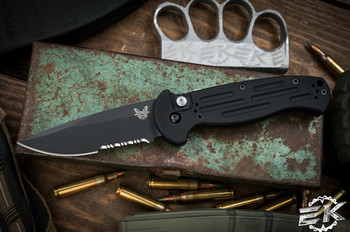Choosing a Survival or Tactical Knife
Posted by Clayton on Oct 28th 2021
There is an endless supply of knives marketed as “Survival” or “Tactical”, with no apparent design philosophy linking them beyond a marketing label. In days gone by, adding a compass for a survival knife or painting it black for the tactical market was sufficient. In today’s market, knowledgeable consumers need to find the purpose-driven designs that satisfy their specific survival and tactical knife needs.
Post-War Beginnings
Modern survival knives evolved from military designs developed for aircrews downed behind enemy lines or in remote areas. The USN and Air Corp/early USAF issued commercially available hunting knives to pilots which evolved through the years. The USAF survival knife was a widely issued, purpose-driven example, designed to cut and hack with the smooth or serrated saw sides of the blade. It had a hammer-like driving surface on the end of the handle, and the blade was stout enough for prying tasks. The phosphated carbon steel was left relatively soft to allow the knife to bend rather than break under harsh conditions - the thought was that a bent knife could still work while a broken one was junk. The leather sheath had a pocket that contained a sharpening stone. First issued in 1958, it is still carried in DoD inventory.

A well-used USAF survival knife with grip wrapped in nylon cord for emergency use.
Experience in Vietnam led the evolution of these blades, with custom knife makers providing models based on customer feedback. Bo Randall created the modern survival knife in this manner, adding blade serrations and a hollow compartment in the handle for gear at the request of military personnel.
The 1982 movie First Blood (aka Rambo) put the survival knife on center stage, featuring a Jimmy Lile creation that could accurately be called Stallone’s co-star. Commercial interest in survival knives skyrocketed and the impact on the market is felt to this day.
Early Tactical Knives
Like the survival knife, commercial hunting products were issued during the wartime scramble to equip rapidly expanding militaries. Many countries modified bayonets for the purpose by removing the parts to attach it to the rifle. The US M3 Fighting Knife is one such example, being a modified M1 Carbine bayonet.
The US Marine Corp issued a purpose-driven utility knife, commonly known as the KA-BAR. It could be used for prying, fighting, hammering, and most other functions that combat soldiers would face. The US Navy adopted it as the MK 2 where it saw success. First adopted in 1942, the KA-BAR can still be purchased in military PXs today.
The Fairbain-Sykes was another contemporary in the development of the tactical knife, bred purely for fighting and without thought to utility. The USMC copied it and issued it as the Marine Raider knife, but its specialized design limited its popularity. It was eventually replaced by the KA-BAR.
Modern Designs
Todays consumer can take advantage of all of the hard-earned knowledge gained throughout the years. Combined with modern manufacturing techniques and materials, world-class products can be had, tailored to a specific need.
Survival knives can be had from Rambo-esque short swords for primitive living type survival to concealable, compact folding designs intended for escape and evasion scenarios. Carefully evaluate your needs and choose accordingly. You may need a two-blade solution – pairing a large knife with a smaller multi-use knife for finer tasks can make sense. Or even a machete or ‘hawk and a fixed-blade survival knife.

Tactical knives have also developed into specialty categories, and the name encompasses fighting knives as well. The tactical knife of a US Navy Seal will be different from that of a LAPD SWAT officer or NYPD Patrolman:
The Frogman will be looking for a multi-role fighting blade similar to that of the KA-BAR, with some sort of wire cutter feature.

The SWAT officer will need something similar, capable of prying and used for making entry, breaking reinforced glass, cutting through wallboard or setting up observation/sniping positions. For the patrolman, a concealable blade that can break auto glass, cut seatbelts safely, cut away clothing for injury assessment, and serve as a backup weapon during a disarm attempt is ideal – especially with one-handed deployment like an assisted opener or an automatic.
Survival and Tactical Knives
These are all very different products but all fall under the ‘Tactical’ umbrella. When choosing, be sure to take a realistic look at your needs – see what your day to day needs are weigh them against the outliers that it might be needed for. Choosing EDC gear based on a once in a lifetime situation (like 9/11) will mean a compromise on every other day that you carry it.
For real-world end users, quality is the keyword. Unless you are going to Scout Camp and can buy a replacement knife before dinner, avoid the cheap knockoffs. A fabulous replacement warranty isn’t going to help you when you are 300 miles from nowhere in the Yucatan, or when your blade snaps while you are trying to extricate your co-pilot from the remains of your bird. Buy right, buy once, and have the confidence that your blade will see you through.

